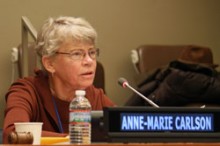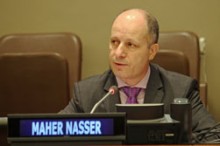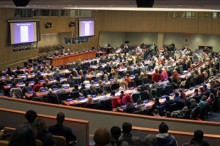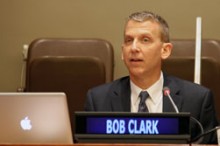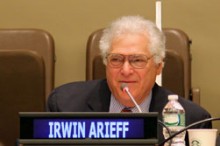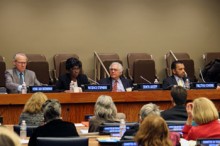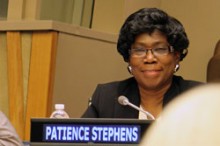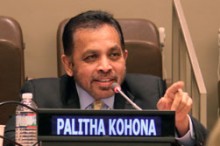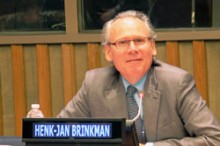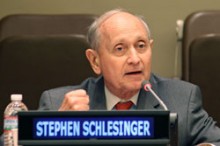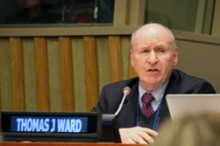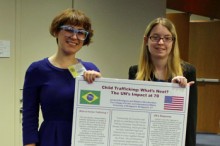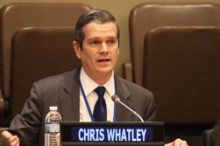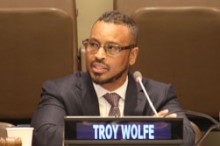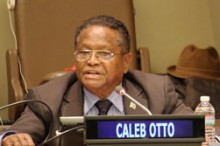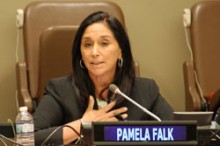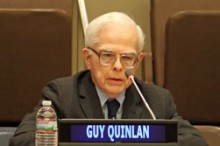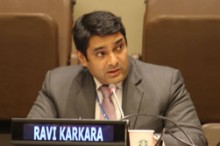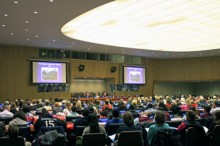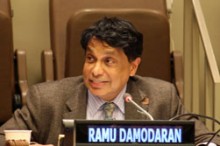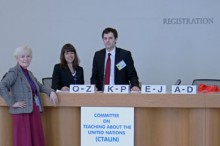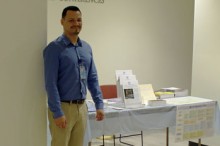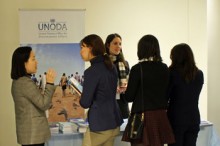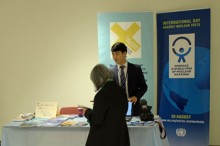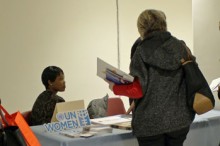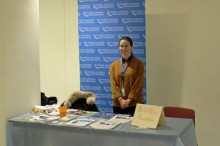2015 UN
16th Annual CTAUN Conference – 30 January 2015 United Nations, NY
THE UN AT 70: MAKING A DIFFERENCE
On Friday, 30 January 2015, the Committee on Teaching about the United Nations (CTAUN) held its 16th Conference at the United Nations. As 2015 marks the 70th anniversary of the United Nations Charter coming into force, the chosen topic of this conference was “The UN at 70: Making a Difference.” The focus of the conference was a brief reflection on UN history and how it has grown from the original 51 member states to its current 193 nations, recognizing its many accomplishments, and appreciating the complex institution it is today
Conference attendees heard why, how, and by whom the UN was founded, what has changed over these seventy years as the UN has adapted to each succeeding decade, and what the future holds as it moves forward to achieve new goals for “2015 and Beyond.”
Our world grows smaller as technology brings us ever closer together and more interconnected. Events happening thousands of miles away have direct impact on each of us. Educators and concerned citizens need to learn about the “only organization that has the worldwide membership, the global reach and universal legitimacy” to tackle today’s many international concerns through diplomacy instead of through violence, and learn how they and their students can contribute to “making a difference.”
WELCOME
Anne-Marie Carlson, Chair of CTAUN, began with a 2-minute video entitled The UN Turns 70, providing a visual overview of the UN’s history. See the video at www.youtube.com/watch?v=utzRwVhTZ2Q
In addition to outlining the topics of the morning and afternoon panels, she welcomed the 496 registered educators and concerned citizens, highlighting the 48 Fulbright scholars from 23 countries in Asia, Africa, Europe, the Middle East and South America engaged as teaching assistants throughout the US, and coming to us through the cooperation of the Institute of International Education (IIE). She also welcomed students and faculty from Nassau Community College and the University of Bridgeport, and two secondary schools: Cranford in New Jersey, and Mott High School in the Bronx.
She detailed the contents of our conference folders, and informed attendees of the 18 exhibits in our Info Fair, through the efforts of our Info Fair Chair, Ruth Nielsen. She then introduced Maher Nasser, acting head of the UN’s Dept. of Public Information (DPI), who spoke briefly about upcoming conferences related to the post 2015 Development Agenda, including sustainability – September in NY, and climate change –December in Paris.
This was followed by a video message from Secretary-General Ban Ki-moon.
MESSAGE OF THE SECRETARY-GENERAL
In his message, the Secretary-General spoke about a call to action with the UN’s 2015 Sustainable Development Goals (SDGs), and asked that we all work toward promoting global citizenship to overcome the insecurity, injustice and intolerance that prevails in our world. He pointed out that there is no subject matter taught anywhere that does not have a UN dimension, and thanked Anne-Marie and the members of CTAUN for our contributions over the years, educating new generations about the ideals and objectives of the United Nations.
OPENING KEYNOTE
Franklin and Eleanor Roosevelt and the Origin of the United Nations
Bob Clark, Acting Director of the Franklin Delano Roosevelt Presidential Library at Hyde Park, NY www.fdrlibrary.marist.edu was introduced by Dr. Thomas Ward, CTAUN member and Dean of the College of Public and International Affairs, University of Bridgeport, who pointed out the importance of recognizing the link between the UN and the legacy of FDR.
Dr. Clark combined his presentation with a slide show. He began by telling us that today (January 30) would have been the 133rd birthday of FDR, the father of the United Nations, and explained in a personal anecdote, his own early fascination with the UN as an example of how teaching young people about the organization can open minds and hearts to the larger world and a larger humanity.
He then gave a chronological history of events leading to the UN’s founding in 1948.
The UN was built on the failure of the League of Nations, due to four major factors: flaws in its structure, lack of enforcement procedures, the harshness of the Versailles Peace Treaty, and President Wilson’s inability to convince an isolationist US Congress to sign on.
Roosevelt learned from this failure. He gradually maneuvered Congress to liberalize the neutrality laws restricting his ability to aid countries fighting the growing Axis powers, culminating in his presentation of the Lend-Lease program on January 6, 1941, and his Four Freedoms speech. Thus he began his campaign to the American people with a vision of the post-war world, even before Pearl Harbor brought us into the conflict. These Four Freedoms – Freedom of Speech and Expression, Freedom of Worship, Freedom from Want (economic well-being), and Freedom from Fear (disarmament), Dr. Clark argues, are the spiritual basis for the United Nations.
Stage 2 was a series of meetings:
August 1941 – His meeting with Winston Churchill – in secret, off the coast of Newfoundland, resulted in the Atlantic Charter, an 8 point declaration renouncing territorial expansion by nations against the wishes of the people in those territories, declaring that all nations had the right to economic prosperity and advancement, access to raw materials, improved labor standards, human rights and social security, along with the right to choose the form of government under which they would live, and the right to a peaceful existence within their own borders. Inevitably this promise of self-determination led to the end of colonialism. Within the Atlantic Charter was the first mention of the term “United Nations.”
January 1, 1942 – A declaration of their wartime alliance, held at the White House, was signed by Roosevelt, Churchill, ambassadors of the Soviet Union, China and 22 other “United Nations”- the first formal use of the title as a name for the group.
November 1943 –At the Teheran Conference with Churchill and Josef Stalin, Roosevelt sketched what became the genesis of the modern UN. The 40 nations fighting the Axis powers gave birth to the General Assembly; similarly, the four major nations, which FDR referred to as the “Four Policemen”– the US, Great Britain, the Soviet Union and Nationalist China, to which France was later added, along with an Executive committee chosen from the larger group, became the Security Council. Those components of the League, which had been successful, were also added – the International Labor Organization (ILO), and the League’s health, agriculture and food administrations.
August-October, 1944 – The Dumbarton Oaks Conference in Washington, DC brought out difficulties over the veto and voting procedure in the Security Council, and the Soviets’ demand of a separate vote for each of their republics (16 in all) in the General Assembl
February 1945 – Despite ill health, FDR met with Churchill and Stalin at Yalta in the Crimea, to resolve these issues face to face. Roosevelt succeeded in getting Stalin to agree to join the Allies against Japan, and to Soviet membership in the UN. Stalin dropped his demand for 16 seats in the General Assembly and got two. All agreed that the Security Council veto would be absolute, and determined that the founding conference would be held in San Francisco. FDR recognized that Cold War differences were emerging, and that the end result was imperfect, but was “the best he could do under the circumstances.” Ironically, he died in Warm Springs on April 12, 1945, without seeing his vision become a reality.
In December 1945, Eleanor Roosevelt was commissioned by President Truman to be the first American woman delegate to the United Nations. Underestimated by the men in charge, she nonetheless won the right of self-determination for war refugees in danger of forced repatriation to their home countries. As a result of her hard work and skillful debate, she was then elected chair of the newly created UN Human Rights Commission, resulting in the Universal Declaration of Human Rights, the yardstick by which our modern concept of human rights and human dignity for men, women and children is measured. It was adopted on December 10, 1948, with 48 votes for, none against, and eight abstentions, along with a standing ovation for Mrs. Roosevelt.
Dr. Clark ended his remarks with an injunction to all of us, that, despite the scourge of war we face today, “we move forward with a strong and active faith.” For “the only limit to our realization of tomorrow will be our doubts of today.”
MORNING PANEL — Striving for Peace and Security
Irwin Arieff – Reuters correspondent for 23 years, writer and columnist for the UN-centric website www.passblue.com
As panel moderator, he spoke much-needed words to those naysayers and critics of the UN.
“Like Toys‘R’Us,” he said, “the United Nations are US. No more, no less.” He focused on the often forgotten fact that the UN, though an international organization, is nevertheless, not a world government, and relies for any action, on the political will of its member states. “Criticism of the UN is easy and seemingly constant,” he said. “But the organization is fundamentally nothing but its 193 member nations. It can only be as good as we – our home nations and their citizens – set out to make it. We are all responsible for making the UN function as well as possible…it is the only place that gives every nation a seat at the table.”
He went on to add that ”The UN’s critics presumably seek changes, although there is no consensus on what those should be, and some would like to abolish the organization altogether. Its most lethal critics mount attacks on peacekeepers and UN offices.
If the UN could no longer do its job, who would be standing by to take its place when it comes to snuffing out ebola, protecting the rights of women, separating the warring sides and helping to rebuild after a conflict?
…The UN may not be moving as quickly or effectively as we would like. But are we not all obliged to help it do the best it can?”
He ended by introducing the three panel members.
Patience W. Stephens – Special Advisor on Education at the UN Entity for Gender Equality www.unwomen.org/en
Ms. Stephens titled her presentation “What Will It Take to Secure Sustainable Peace and Security?” She started with the expectations critics have of the UN – to prevent and end wars, provide humanitarian assistance, and broker peace – in the words of the prophet Isaiah, “to beat our swords into plowshares.”
“All well and good,” she says, and in many contexts the UN has worked hard to comply. Yet, due to “injustice, poverty, inequalities, social exclusion and poor governance, peace and security last only for a while, until the broken pieces of the plowshares are gathered again and fashioned back into swords and weapons that are even more deadly and intractable. Thus the conditions we thought we had addressed can become more insidious than before.”
What is the answer? Ms. Stephens contends that it lies in economic and social development and relevant quality education, and that these are critical to sustainability. She points out that many fail to make the connection between development and peace and security, and give less recognition to UN efforts in the development area. “But,” she says, “a society of want is bound to be a society of strife and conflict, and community level strife over time becomes national and international.”
To level the playing field requires education. As of 2012, 58 million primary-aged children, and 63 million of elementary and lower secondary age were still out of school. The majority are girls who will become mothers and pass the deprivation and poverty on to the next generation. Even those who are in school lack access to basic learning materials, qualified teachers, facilities and technology. The fact that some of the most heinous crimes against women – rape as a tool of war, for example- are perpetrated by well-educated people, does not negate the value of education. But it does indicate the need for an assessment of how we educate. Are we educating for division or global citizenship? It’s no longer about chalkboards and passing tests, but civic education and community engagement.
In 2000, the Security Council passed Resolution 1325, which made the important connection between gender and peace and security, bringing gender perspectives to the center of all UN conflict prevention and resolution, peace-building, rehabilitation and reconstruction efforts, and, for the first time, opening a way for women to have a seat at the negotiating table. If this is to be implemented, the private sector – foundations and individuals – must continue to partner in the effort. She concluded by saying that “the imbalances of inequality, injustice and discrimination are greater threats than the swords we have muted… We should continue to beat swords into plowshares, but…bring all on board for the harvest.”
Dr. Palitha Kohona – Ambassador and Permanent Representative of Sri Lanka to the UN www.slmission.com
Ambassador Kohona’s presentation focused on the achievements that his country, after 27 years of terrorism, has been able to accomplish, thanks, not only to its own efforts, but with the support of the UN as well. He credited especially the United Nations Development Fund (UNDP), the United Nations Children’s Fund (UNICEF), the Office of the High Commissioner for Refugees (UNHCR) and the Office of the Commissioner for Humanitarian Affairs (OCHA).
Since joining the UN in 1955, Sri Lanka has played an important role in peacekeeping. A large contingent of Sri Lankan peacekeepers was sent to the Congo in 1960, and later to Haiti, South Sudan, and the Central African Republic, including a unit of women ready to go wherever required.
For its part, the UN during times of conflict, sent food and supplies, through the World Food Programme (WFP), even to those areas inhabited by forces attempting to destroy the country. Thanks to UNICEF’s support with makeshift schools and nutrition, the infant mortality rate is now 8.9%, similar to that in most developed countries, and the maternal mortality rate is also down. In addition, Sri Lanka now has a literacy rate of 98%. In 2009, 400,000 internally displaced persons (IDPs) were housed in camps with the help of UNHCR and OCHA. Between 2009 and 2012, Sri Lanka put in place a resettlement program that has become a model for other post-conflict nations. With their ‘go and see’ method, displaced people were sent back to their villages, and today there are no camps in the country. OCHA brought seeds and tools to the resettlement areas, so that now there are bumper crops, and the fishing industry has expanded by 27% as well. Bi-lateral donors refurbished schools and medical facilities. Their family reunion program is still ongoing with the help of UNHCR.
Dr. Kohona ended by saying that UN assistance cannot be ignored, and is very much appreciated.
Henk-Jan Brinkman – chief of the Policy, Planning and Application Branch of the Peacebuilding Support Office in the UN Secretariat www.un.org/en/peacebuilding/pbso
Dr. Brinkman began by saying that the world is changing, and the UN with it. In 1989, the fall of the Berlin Wall and the collapse of the Soviet Union caused a paradigm shift. March of that year gave birth to the World Wide Web, and the resulting interconnectedness facilitated trade on the one hand, and transnational crime and terror networks on the other. The UN has become more fragile and multi-polar, as compared to the bi-polar world of the Cold War, and therefore, more crisis – prone. We live in a world without borders, with multi-dimensional problems.
The nature of conflict has changed. Wars between countries have been replaced by internal conflicts. 1940’s, ‘50’s, and 60’s wars of independence and proxy wars between the US and the Soviet Union in the developing world have given way to multiple little wars, involving rebels, gangs, extremists, and terrorists, and now there are no frontline zones, no distinctions between soldiers and civilians, and higher homicide rates. Ideology and political goals are less of a driving force as the pressure for international resources, exacerbated by climate change, increases. Grievances over corruption, human rights abuses, and funding of terrorism by criminal organizations make it impossible to resolve difficulties by diplomacy or military means alone.
Change in the UN has been rapid. Before the end of the Cold War in 1989, the Security Council was blocked by vetoes. Now sanctions are used more frequently and are targeted. Peacekeeping operations, which heretofore involved only facilitating a peace that both countries wanted, have increased drastically, fueled by the concept of Responsibility to Protect, and threats to peace and security such as HIV/AIDS and Ebola. Special political missions on the ground do not involve the military or the police.
There is greater integration in the UN system, departments working across the system in the field as well as at Headquarters. In 1992, Secretary-General Boutros-Boutros Ghali’s ‘Agenda For Peace’ introduced the idea of peacebuilding, to reduce the risk of post-conflict relapses into violence. In 2005, SG Kofi Annan declared that 40% of countries that had ended civil wars had relapsed within the next 10 years.
Peacebuilding is peacekeeping amplified to include human rights, humanitarian issues and development. It is not, however, Dr. Brinkman told us, a silver bullet, because it depends on the political will of the Member States as well as having the information to act quickly enough. A review of the architecture of Peacebuilding is imminent, and 2015 will be critical.
SPOTLIGHT ON UN HEROES
Stephen Schlesinger –Senior Fellow at the Century Foundation in NY, and author of Act of Creation: The Founding of the United Nations. www.stephenschlesinger.com
Dr. Schlesinger chose two heroes he thought had the greatest impact on shaping the UN as we know it today: Franklin Delano Roosevelt and Dag Hammarskjold.
His remarks about FDR amplified what Bob Clarke had presented earlier.
He spoke about the foresightedness of FDR, Assistant Secretary of the Navy under Woodrow Wilson and vigorous campaigner for the League of Nations as a Vice-Presidential candidate in 1920, who, as President in 1939, as the Second World War was about to break out, secretly instructed the US State Department to start drafting a UN Charter.
Having learned from Wilson’s mistake of excluding most Republicans from participation in the US delegation at Versailles, possibly a strong reason why Congress ultimately failed to support the League, Roosevelt put together a bi-partisan delegation to the founding UN conference in San Francisco. Four of his powerhouse selections – Harold Stassen, Averill Harriman, Adlai Stevenson and Nelson Rockefeller later went on to become presidential candidates, and one – John Foster Dulles – became Secretary of State.
Two further politically savvy moves were ensuring that the conference was held during wartime, when most of the global states would feel the need for UN protection, and his acceptance of the veto in the Security Council, knowing that neither the US nor the USSR would join the body without it. His idealism was evident in his concept of the General Assembly, where all states could feel equal.
But perhaps his greatest legacy was his determination to establish the UN at all. The US, at the end of WWII was at the height of its powers. Roosevelt didn’t have to sign on. He could have made independent alliances with other nations to resolve foreign crises. His realization that only a permanent organization could protect America’s security interests is what gave him visionary status. He was so taken with the institution that, before his death in 1945, he privately mused about resigning the presidency to become the first Secretary-General.
Dag Hammarskjold was the second UN Secretary-General, and as Dr. Schlesinger states, “undoubtedly the finest this organization has ever had,” setting the parameters for all who would follow him. He was appointed in April 1953, following the single-term tenure of Trygve Lie, an activist former labor leader, abhorred by the Communist members of the UN. Hammarskjold, on the other hand, was seen as a quiet technocrat, unlikely to make waves, which is why the Russians agreed to his selection, much to their later regret.
Son of the Swedish Prime Minister during WWI, Hammarskjold had spent 16 years as a civil servant in Sweden, evincing great administrative abilities, but no evident ideology. He was also a loner, unmarried, an intellectual, poet, and translator, with mystical leanings. His spiritual diary, Markings, was published after his death. (See Teacher Resources section for annotation.)
Two of the crises defining his tenure illustrate his uncanny ability to shape events, his tremendous creativity and tenacity, extraordinary organizational skills, and his capacity to act as a moral leader for the UN.
In 1956 when Great Britain, France and Israel attacked Egypt for nationalizing the Suez Canal, Hammarskjold, in a firm speech to the Security Council, stated his belief that the role of the Secretary-General was “to serve the UN Charter, above any considerations of member states,” and that if the member states felt that another view of his duties would better serve the organization, they had the right to act accordingly. Some took this as a threat of resignation, and all the permanent members hastened to give him their vote of confidence. It was an act of integrity and daring that instantly increased his moral standing. He later urged and got a ceasefire, replacing the invading nations with 6000 “blue helmets” – the first official use of peacekeeping operations in the UN’s history. All this was assembled in less than a week.
The second crisis came in 1960, when the Belgian decision to withdraw from its colony in the Congo, left a leadership gap that the eventual Prime minister, Patrice Lumumba, could not fill. Despite 20,000 UN soldiers sent to protect him, Lumumba was nevertheless ousted and murdered. The Soviet Union blamed the regime collapse on Hammarskjold, and demanded a 3-man “troika” arrangement to replace the Secretary-General – one representative from the West, one from the USSR, and one from a neutralist nation. Hammarskjold, citing the Charter, refused to resign and received a standing ovation from the General Assembly. Moscow dropped the idea, and Hammarskjold’s stance cemented the notion of the UN Secretary-General as an activist world leader. With further chaos in the Congo, in 1961 he flew to Northern Rhodesia (now Zambia) intending to negotiate with Moise Tshombe, leader of the breakaway region of Katanga. Instead, he lost his life in the plane crash that ensued, the only Secretary-General to die in office. Posthumously, he was awarded the Nobel Peace Prize.
Dr. Schlesinger left us with a memorable Hammarskjold quote. “The United Nations was not created to bring us to Heaven, but to save us from Hell.”
BEST PRACTICES
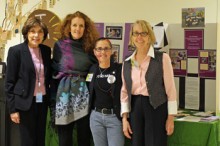
CTAUN Best Practices Award Chairs Joan Goldstein and Mary Metzger with Winners Principal Lisa Fernandez and Art Teacher Kate Judge Patton from PS 119, Brooklyn
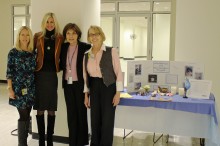
CTAUN Best Practice Award Chairs with winners Charlotte Mourlout and Karen from the United Nations International School
CTAUN Best Practices Awards for 2014 were presented by co-chairs Joan Goldstein and Mary Metzger, to two sets of recipients who followed up on last year’s conference theme, “Promoting Peace Through Education”. Each was given copies of two books, A Path Appears by Nicholas Kristof and Sheryl Wu Dunn, and Act of Creation by Stephen Schlesinger.
Principal Lisa Fernandez and Art Educator Kate Judge Patton of PS 119 – The Amersfort School of Social Awareness: Magnet School of Global and Ethical Studies, in Brooklyn, NY, were honored for their project entitled “Celebrating the International Day of Peace.” The other award went to Karen Ager, Learning Specialist and Charlotte Mourlot, Fourth Grade Teacher at the United Nations International School (UNIS): Junior School, in Manhattan, for their “Mindfulness and Peacekeeper Project.” (For details, see our Best Practices Section.)
CTAUN POSTERS DISPLAY
Dr. Thomas Ward introduced the winners – a group of University of Bridgeport graduate students representing 8 countries. They included Beltina Gjeloshi from Albania, Mohammad Aynal Haque from Bangladesh, Janaina Bordignon from Brazil, Mostafa Hassan from Egypt, Joel Amegboh from Ghana and Togo, Fidaa Alfalata from Saudi Arabia, and Brandon LaFavor and Rebecca Bruckenstein from the US. Each poster addressed an issue related to a way in which the United Nations has made a difference in today’s world. Anne-Marie Carlson gave certificates of merit to the poster artists, who were available to speak with conference attendees during the lunch break that followed. 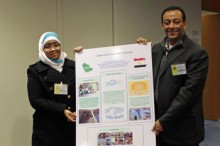
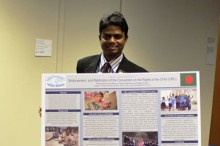
LUNCH – INFO FAIR – BEST PRACTICES EXHIBITS
Exhibitors included UN agencies including UN Women, UNICEF, UN Office of Disarmament Affairs, IAEA (International Atomic Energy Agency), and private organizations such as the UN Foundation, and UNA/USA.
AFTERNOON SPOTLIGHT: The Economics of Globalization
Introduced by Chris Whatley of the United Nations Association of the USA (UNA/USA). www.unausa.org , a membership organization that works to support and inspire Americans to learn more about the UN. Their major platform and learning tool is Model UN.
He spoke about what he called ‘disruptions’ related to technology: how the IT revolution of the last 25 years has affected expectations and educational thinking; an article in the Washington Post entitled “Will Robots Replace Journalists?” and the fact that technology now threatens white collar as well as blue collar jobs.
He also spoke about how the teaching of team building and critical thinking are still slowed down by old assumptions that education consists of mastering and regurgitating content, and by current Common Core standards. Today there are 13,500 independent school districts or “decision-making units” which must coalesce around these national standards. He added that of the 55 million K-12 students in the US, perhaps only 100,000 have any classroom experience with Model UN.
The goal of their new program is to scale down Model UN. It doesn’t have to be in a conference format, but can be made more accessible by delivering it in a school or classroom for shorter and varying amounts of time – in a 45-minute class period, for example. It also aligns the components to Common Core standards.
He then went on to introduce UNA/USA’s Director of Education Programs, Troy Wolfe, who designs programs supporting more than 150 chapters of UNA/USA. twolfe@unausa.org
“There are 25,000 participants enrolled annually in Model UN,” (the conference model) Mr. Wolfe told us, and went on to describe the new curriculum.
The Economics of Globalization is a program designed to give students the knowledge and skills to become global citizens in a more accessible form. Through a Teachers Guide of 33 suggested lessons, student readers and primary source readings, accommodating various reading levels, students engage in the human story of globalization –learning financial literacy and the effect of financial decisions on daily lives, and how they themselves fit into the global economic picture. Each unit of interactive lessons, based on the Piagetian model, culminates in a mini-Model UN simulation, which takes the best of Model UN and puts students in the position of ‘the other,’ allowing them to attempt to solve real-world problems.
The curriculum is online. They also have a Model UN App: www.unausa.org/global-classrooms-model-un/model-un-mobile-app that connects with the UN and the US State Department. For questions send an e-mail to them at UNA-Education@unausa.org.
AFTERNOON PANEL — Advancing Human Dignity and Social Justice
This Panel was moderated by Ravi Karkara, Global Advisor on Youth and Partnership with the UN Millennium Campaign and UN-HABITAT. www.youthaward.org/partners/ravi-karkara
Mr. Karkara introduced Dr. Caleb Otto –Ambassador and Permanent Representative of the Republic of Palau to the United Nations www.palauun.org
Dr. Otto, who is also a Medical Doctor, spoke about the often unrecognized connections between climate change and human dignity – loss of land, people, cultural heritage and sovereignty. In the Marshall Islands and Tuvalu, for example, food security is an issue due to the fact that agriculture is carried on in coastal areas, and high sea levels increase salinization. Also, rebuilding after storms is rarely completed before another storm hits, causing economic instability. Food must be imported, and because most people live in coastal areas, many must be evacuated and relocated. This leads to psychosocial stress, intercultural issues and loss of sovereignty due to being a minority culture in the new islands where they seek refuge. Fishing habitats are also at risk. He advocates for a ban on commercial fishing, especially with regard to foreign fleets. Palau is known as one of the Seven Wonders of the Underwater World for its diverse wildlife and marine ecosystems, protected in a marine sanctuary of ½ million square kilometers.
Pamela Falk –UN Resident Correspondent for CBS News TV and Radio, and professor at the Roosevelt House Human Rights Institute of Hunter College. www.cbsnews.com
She began by saying that freedom of expression is not optional, but an inherent human right. She voiced her belief that language to this effect be included in the upcoming Sustainable Development Goals (SDGs).
She spoke about World Press Freedom Day and went on to say that the press is under siege in the world, and that imprisonment of journalists, and female sexual assault are at an all-time high. Over 1000 have been killed. “If it bleeds, it leads,” she said. In 2013 the UN General Assembly passed a resolution on safety for journalists.
Addressing the causes of hostility toward journalists, she cited the reach of information through social media, which poses a threat to powerful regimes, and challenges state media. The numbers are mind-boggling. “If Facebook were a country,” she said, “it would be the third largest member of the UN.” There are something like 200 million blogs worldwide. She strongly believes that there is a need for rules to govern political surveillance on digital media. She ended by referring to “digital diplomacy,” giving us an entertaining sample of UN communication using only acronyms.
She can be followed on Twitter @PamelaFalk
Guy Quinlan – President of the Lawyers’ Committee on Nuclear Policy (LCNP) and Program Coordinator for the NGO Committee on Disarmament, Peace and Security. www.guyquinlan.com
He began by reminding us that the UN’s first resolution called for the elimination of atomic weapons, and went on to mention two significant anniversaries:
It is now 45 years since the Nuclear Nonproliferation Treaty of 1970, a commitment the International Court of Justice held to be binding under international law. Yet today, the planet is still infested with 16,000 nuclear weapons, with many times the destructive force of those used at Hiroshima and Nagasaki. Far from eliminating their arsenals, nuclear weapons states may spend a trillion dollars modernizing and enhancing them over the next decade – resources which could better be used to combat poverty and disease, to build schools and health clinics, and to develop sustainable agriculture and renewable energy.
The second anniversary happened 20 years ago on January 25, 1995, when the world came within minutes of an accidental nuclear war. On that day, Norway launched a weather research rocket that, on radar, appeared to have the characteristics of a ballistic missile. Notice of the launch failed to reach the right people in the Russian military, and it was only at the last minute that Russian defense officials were able to determine that the rocket’s flight path was not a threat. Mr. Quinlan gave us the frightening information that this was not a single episode, and detailed several others, over the years, in which, through human or computer error, we were brought to the brink of disaster. He questioned whether we should bet the future of our children and grandchildren on the assumption that our luck will last forever.
Scientific studies have shown that an exchange of the present US and Russian arsenals would cause climate conditions not seen since the last Ice Age, and threaten the survival of the human species. Even a regional nuclear war, fought with relatively small atomic weapons, could cause a collapse of world agriculture, putting two billion people at risk of famine.
There are hopeful signs. In 2012, the UN General Assembly established the Open-Ended Working Group on multilateral disarmament negotiations. In 2013 and 2014 more than 100 countries participated in conferences held in Oslo and Vienna to focus attention on the horrific humanitarian consequences of nuclear explosions. Increasing numbers of young people in non-nuclear states are protesting the nuclear threat to their future.
Unfortunately, little public or media attention has been paid to these developments in nuclear weapons states. He thanked CTAUN for addressing the topic, and pointed out the vital role teachers must play in spreading knowledge of the dangers and the need for action. None of the other goals discussed today–human rights, sustainable development, or the eradication of poverty have a chance of success without it.
Ravi Karkara then introduced a 6-minute video illustrating the work of Ken Payumo, Chief of the Peacekeeping Operations Support Section for the Department of Safety and Security, responsible for overseeing the security of UN peacekeeping missions. See it at www.youtube.com/watch?v=24beuomCwPk
Mr. Payumo is considered a UN hero. When men with guns attempted to enter the UN camp in Bor, South Sudan, he stood up to the South Sudanese military, refusing to allow them to enter the camp where 12,000 refugees had fled for safety. His actions are thought to have saved thousands of lives.
Mr. Karkara is also an Advisor to UN Women, and in this capacity he mentioned another UN initiative this year: Beijing+20 = the 20th anniversary of the first UN Conference on Women. He invited everyone to participate in the upcoming march for gender equality and women’s rights scheduled for International Women’s Day (Sunday March 8), starting at UN Headquarters and ending in Times Square.
INSPIRATIONS
CTAUN members Ann Grosjean, Peggy Montgomery and Eileen Venezia selected four notecard statements from among many submissions, and invited the writers to the podium to share especially moving moments in the day’s program. The speakers included Dr. Linda Dix, Religious Education Director at Our Lady of Good Counsel in NJ, Esther Taubert, a Fulbright Teaching Assistant from Germany working at Lycoming College in PA, Camila Siegel Masias, a Fulbright Teaching Assistant from Argentina also working at Lycoming, and Elsa Rodriguez, a high school student from Cranford, NJ.
CLOSING KEYNOTE
Ramu Damodaran – Chief of the Academic Impact Secretariat and Deputy Director for Partnerships and Public Engagement, Outreach Division, UN www.academicimpact.org
With his characteristic humor and love of acronyms, this friend of CTAUN, recognizing that our conferences are always held on a Friday, told
us that in India, from which he had just returned, TGIF stands for “Truly Good Indian Food!”
In summing up the day, he pointed out the many references to FDR, particularly his radio address of October 24, 1944, in which he spoke about the importance of embracing the new; and his attempts to reconcile a “necessary war” (WWII) with the concept of sustained peace. He then divided the 70 years of UN existence into 5 spans of 14 years, each defined by a specific element representing the letters in CTAUN:
1) 1945-1958 – Element of CONSCIENCE. This involved acknowledging our collective sense of guilt over two wars in one generation, and the holocaust, leading to the creation and sanctioning of documents, such as the UN Charter, the Universal Declaration of Human Rights, the Convention on Genocide and others.
2) 1958-1972 –Element of TRANSFORMATION. In resolving problems of decolonization and giving people a say in their own forms of government, lives were transformed and UN membership expanded. For example, when South Africa refused to relinquish control of what would become Namibia, the UN took control, giving people a sense of what the Secretariat could do to transform the planet and individuals. At home, President Eisenhower urged community projects supporting the UN, and analyzing its accomplishments.
3) 1972-1986 – Years of ACTION. These were the years in which the UN began to give conferences outlining specific steps that countries could implement on a practical level – the first world conference on the environment, others on food, employment and children.
4) 1986-2000 – UNDERSTANDING. “Where understanding is lacking, there is no commitment to solutions.” Without education, for example, the need for recycling would never have been recognized. Here he outlined projects of the various groups represented at the conference –Nassau Community College, Delta Kappa Gamma, the University of Bridgeport, and Lehigh University, where education is now linked to global solutions, to community and industry. He mentioned the Achilles Project of Nassau Community College teaching cognitive skills to students who are “twice exceptional” both physically and developmentally, and compared it to UN efforts to bring ‘disabled’ nations out of servitude and poverty.
5) 2000-2015 – Element of NORMS for the Millennium Development Goals (MDGs). We need norms for civilized behavior, understanding of one another and not just the system. We need to talk to, and not at, one another. All these elements need to be instilled in our students. He urged educators to “think as big as possible,” and to be prepared “not to tinker, but to transform.”
Thanks to back-up note takers Alexa Ward, Martha Chatterjee, Nancy Brown, Mary Metzger, Alice Siegal, Lochie Musso, and Ann Grosjean, and to Peggy Montgomery for reviewing this report.
Toni Giangrande
OTHER PICTURES OF THE DAY
Photo Credits: Don Carlson

